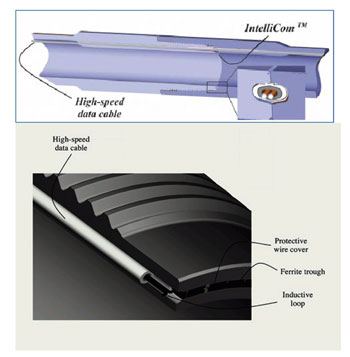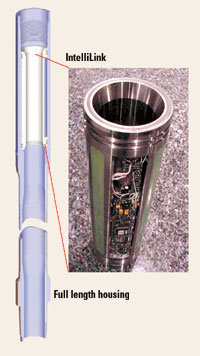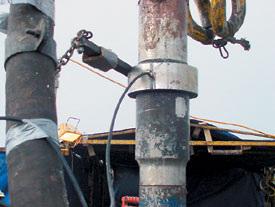Drilling Report
Real real-time drill pipe telemetry: A step-change in drilling
High speed data transmission through the drill pipe has been a long-sought goal – it’s finally nearing commercial use
Perry A. Fischer, Editor
For over 50 years, technology has been proposed that would allow formation evaluation and borehole navigation while drilling in real-time. The savings in drilling/rig time and cost would be substantial. In 2000, Grant Prideco and Novatek formed a joint venture corporation, IntelleServ, to commercialize a high-speed drill pipe telemetry system. In 2001, US Department of Energy’s National Energy Technology Laboratory (NETL) partly funded the venture. The need and uses for this technology, its design, testing and status to date are discussed herein.
BACKGROUND
For the past two decades or so, the need to improve real-time has been partially met by LWD/MWD systems that use mud-pulse telemetry to get the data to surface. This technology is limited by a data transmission rate of, at best, 10 bits per second. This severe limitation means that the data must be more sparse, decimated or summed – all of which limits resolution and eliminates certain data-intensive measurements. Retrieving the data also slows drilling operations. In addition, mud-pulse transmission cannot be used with foam- and gas-based drilling fluids.
In recent years, three technologies have emerged in an attempt to further improve downhole data transmitted in real-time: memory logging on drillstring, electromagnetic (EM) transmission, and disposable optical fiber.
Memory logging on drillstring – although comparable in resolution to electric line logging – is far from real-time, even if the memory module can be circulated to surface. It is best used in situations where electric line cannot be applied, such as deviated and difficult holes.
Another technology, EM transmission, suffers from rapid attenuation of signal. This limits it to shallow depths. Even though hanging off antennae in the drill pipe can extend its depth range, this practice is time consuming and potentially problematic. When EM’s added cost is combined with its limited depth range, the technology becomes most appropriate in certain niche applications, such as shallow TVD, under-balanced extended reach wells.
Currently under development is a disposable, fiber optic telemetry system. Proposed in the early '90s at Sandia National Laboratories, the idea received initial funding and passed several testing hurdles. However, the project languished several years until 1999, when GTI and a major service company took an interest in the project. GTI acquired the patent and partnered with Sandia Corp.
The lightly-protected, inexpensive fiber runs the length of drill pipe, from the BHA to surface, and is capable of transmission rates in the 1 million bits per second range. The fiber can be circulated downhole from a surface spool, as well as reverse circulated up from the BHA. For the latter, a special downhole fiber-spool/sub assembly, 10-ft long and weighing less than 100 lb, is being tested. Several hurdles have been overcome and field tests have demonstrated proof-of-concept. Most important, the two greatest concerns – abrasion and breakage of the fiber due to circulation pressures – turned out not to be serious problems. The current effort has focused on temporary deployment of the fiber as the bit nears the zone of interest, rather than continuous deployment from spud of the well. The project has been licensed to a major service company, with commercialization hoped for within two years.
At least 10 patents have been issued during the last 50 years in attempts to create drill pipe telemetry, using both hard-wired and induction-based transmission across connections, but none of these have neared commercialization. Like all hard-wired jointed systems thus far, the electric contacts at the drill pipe joints proved too difficult to reliably align, allow perfect contact, and not leak under field conditions. Induction across couplings has a host of problems, most notably signal/field losses and the need for downhole signal-boosting.
In 1997, NETL funded a research and development firm, Novatek, in Provo, Utah, to develop another long-sought goal: a reliable, long-lasting, mud-driven, steerable, percussion drillbit system. Ideally, a high-speed real-time feedback was required for the system, but such systems were unavailable. The company realized that solving the feedback problem was at least as big a project as the percussion drillbit.
Enter Grant Prideco, the world’s leading drill pipe manufacturer. Its expertise in drill pipe and coupling design, together with its downhole know-how and marketing abilities, made it the perfect match with Novatek’s research. In 2000, the companies formed a joint venture, IntelleServ, with the goal of commercializing a high-speed drill pipe telemetry system. In 2001, NETL partly funded the venture.
THE SYSTEM
It was realized early on that hard-wired drill couplings, no matter how well designed, would probably always be prone to failure as the number of connections and the many connect/disconnect cycles grew. Therefore, induction was chosen as the means to transmit data from joint to joint. This, however, carried with it many problems to overcome.
The transducer coupling. Each section of drill pipe has an armored wire running along its inner wall, exposed, but able to withstand the rigors of circulation. At each end of each joint of drill pipe, the wire “dives” into the threaded end, and terminates in a loop that is embedded within a groove at the pin/shoulder end of the joint, Fig. 1. Loops from adjacent drill joints are remarkably close, which is one improvement over previous systems. This induction “connection” is called IntelliCom. The immediate concern was: To what extent will this weaken the connection? As it turns out, Grant Pridco’s double-shouldered eXtreme Torque drill pipe had an ideal location for such an embedded loop. Stress analysis revealed that it would not unduly weaken the connection, while full-scale, cantilever beam, drill pipe fatigue testing did not result in any cracking or failure in the modified region.
 |
Fig. 1. The armored data cable runs along the inside pipe wall until it disappears into the threaded shoulder (top). To minimize signal loss, the wire coils are placed in a ferrite trough to help focus the EM energy (bottom).
|
|
The signal booster/conditioner. Induction works on the same basic principle that generates electricity – namely, that whenever an electromagnetic field is moving over a stationary wire (or vice versa), electric current is generated in the wire.
In this application, the two ends (pin and box) of adjacent drill joints, with their embedded wire loops, comprise the transmitter and receiver coils. Downhole conditions and the drill pipe material itself, all affect the ability of the signal to transmit across the coupled joint. Depending on these conditions, plus well depth and desired signal quality, the transmitted signal will eventually degrade to useless after, say, several thousand feet.
To prevent this, the IntelliServ system uses downhole signal boosters and conditioner circuits, housed within the wall of a special sub called an IntelliLink. The sub is in turn housed within a special joint of drill pipe, Fig. 2. The steel booster sub has a large ID to prevent pressure losses in fluid flow and to allow through-drill-pipe devices easy passage. To ensure success, one of these booster joints is placed every 1,000 ft, at least thus far in recent tests.
 |
Fig. 2. The special downhole sub is placed every 1,000 ft or so to amplify and condition the signal. The sub is housed in a specially designed joint of drill pipe.
|
|
Delivery at surface. Another induction loop device is placed at the surface in the form of a slip ring. It strips off the signal and routes it to conventional high-speed data transmission technology, Fig. 3. From there, data can be delivered via satellite or Internet anywhere.
 |
Fig. 3. At the drill floor, the signal is stripped off via a slip ring. From there, it can be routed anywhere.
|
|
It’s important to keep in mind that this technology is envisioned as universal transmission technology, where various sensors and measurements can be made anywhere along the drillstring – from the bit to the surface – and two-way communication access is allowed at any point where there is an IntelliLink. The idea of an integral wire loop in a threaded connection can be applied to all manner of drillstring components. Measurements may come from many sources, not just LWD/MWD. The IntelliLink joints, for example, are to be equipped with sensors similar to MWD tools. When viewed as a network, these access points are known as addressable nodes.
FIELD TESTS
More than two hundred 5-7/8-in. Intelli-Pipe joints have been manufactured and tested. Initial testing of prototypes took place in a 1,000-ft well in Provo, Utah, at IntelliServ’s test facility. From there, a 2,000-ft well was used at the Gas Technology Institute’s test facility at Catoosa, Oklahoma. A deeper, more complete test involving some drilling occurred in February 2003 at the DOE’s Rocky Mountain Testing Center in Wyoming.
A 6,000-ft well was used, into which 121 joints comprising a combination of IntelliPipe, IntelliLink and heavy weight pipe (IntelliHeavyweight) were run into the hole. The first 3,000 ft were already cased, but below that a cement plug was used as a kick-off point and 400 ft of new section was drilled and flushed. At that point, a previously drilled, badly washed-out section of the original wellbore was encountered, and the BHA fell back into open borehole. On one trip, as more drill pipe was added, it became necessary to ream nearly 1,000 ft of tight section, and jars were fired several times.
Total string length, including the BHA, was 4,531 ft. A data transmission rate of 2 million bits per sec (Mb/sec) was established through the system for all tests. Five IntelliLinks were used as network nodes and data collection points in the test.
APPLICATIONS
As previously alluded to, one technology that can now move forward is Novatek’s steerable percussion drillbit. By extension, most steerable technology can benefit from high-speed data transmission capability. In general, all manner of resolution can benefit, especially formation evaluation measurements.
Seismic measurement is one area that will immediately benefit from this technology, since it is so data intensive. It is not uncommon to have problems with time-to-depth conversions of seismic data, especially in very deep offshore wells or when targets are beneath salt overhangs. A typical solution to this is a walkaway VSP on wireline, followed by a quick depth adjustment of the target in a post-stack depth migration. With this telemetry technology, these VSPs could be quickly shot, acquiring not only time but also full waveform information. The telemetry system will also allow look-ahead seismic-while-drilling in real-time at more than 1 Mb/sec.
Another situation that would benefit is in underbalanced drilling operations, when foam or gas is used for drilling. Foam or gas will not support mud-pulse transmission.
When special subs and other downhole equipment is appropriately outfitted with sensors, a wide range of applications opens up. For instance, more precisely locating stuck pipe. Casing points can be optimally located, and the location of a gas kick and progress of any gas bubble to surface could be determined. Perhaps most important, real-time, high resolution data on reservoir formations will allow optimal borehole placement for maximum productivity.
CONCLUSION
It should be emphasized that this technology is still in development. Although the company had an early commercialization date of late 2003, that date has slipped to at least mid-2004. However, this is not pie-in-the-sky stuff. This technology will move forward.
Improvements are still being made to the prototype system. Just looking at the downhole electronics in Fig. 2 begs the question of high-temperature tolerance. Although IntelliLinks are now spaced at 1,000-ft intervals, with increased effort, experience and favorable downhole conditions, this spacing will likely be substantially increased, perhaps to 5,000 ft. Fewer downhole electronics will inherently improve reliability and lower costs. At this juncture, any problems encountered seem workable – indeed, they have been virtually eliminated in LWD/MWD systems, so it’s likely that this technology will overcome any difficulties as well.
There is also a sense of the chicken vs. egg syndrome. High-speed transmission requires high-speed data sensors. No company can be expert at all things, so collaboration with other companies is essential. A brief list of the expertise that’s needed to make this leap in drilling technology includes: drill pipe design and manufacture; electronics design and manufacture; uphole/downhole communication software, uphole server routing, interfacing with other vendors’ application software, modification and compatibility of existing LWD/MWD systems to take advantage of the dramatically higher bandwidth, and so on. These and many other issues will keep IntelliServ in constant discussion with clients and service providers to bridge the gaps in expertise. The company is now seeking clients that would like to see this system tested in full-scale field trials.
Cooperation and collaboration are essential. But what role will competition play? Will someone try to dominate this new future? Will mega consortiums be formed and standards set for others? Or will several joint ventures/alliances form in competition with one another? The answers to those questions are now being mulled over. Whatever the outcome, this technology will likely follow a path similar to LWD systems: gradual acceptance in the highest cost wells at first, followed by expansion into moderately expensive wells. The future is almost here. 
ACKNOWLEDGMENTS
IntelliPipe, IntelliCom, IntelliHeavyweight and IntelliLink are registered trademarks of IntelleServ. eXtreme Torque is a registered trademark of Grant Prideco.
|





